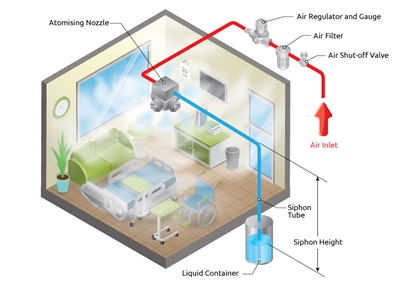Spray reach for disinfection applications
When conducting a disinfection operation, the main job of the spray/fog nozzle is to ensure that the disinfectant reaches the target surface or air space. For sanitising chambers or conveyor based sanitising processes, reach can normally be achieved from direct line of sight of the nozzles. The system will be designed such that the nozzle system will be able to directly target all parts that need disinfecting. For larger, room sized applications other methods of reaching all areas may be required.
Fogging

When we achieve a low droplet size (sub 40 microns) the spray becomes highly suspended in the air and will move around in air currents This can help carry the spray to places beyond the direct line of sight of the nozzles. Of course, this same phenomenon may also be problematic if the disinfectant needs to remain in a discrete area.
The rapidity of distribution by air currents will depend very much on the natural air movements within the areas. Natural air movement can be improved with the use of fans to help distribute the fog/mist. Also in air atomising nozzles the fluid will be projected quite far from the nozzle, much further than high pressure misting nozzles, and so the use of these nozzles will help greatly with initial fluid distribution.
The droplet size will also be an important factor. Not all fogs are equal. Fogs/mists with droplet sizes in 20–40 micron range will settle out of the air more rapidly and, hence, will require swifter distribution to get to the target areas. 10-20 micron fogs will remain airborne for much longer and so can be distributed more slowly and still be effective at reaching difficult areas. Sub 10 micron fogs tend to remain airborne for very long periods of time without much settling so will, over time, naturally distribute to fill an entire air volume. However, this does need to occur before complete evaporation occurs so the length of time available is not infinite.